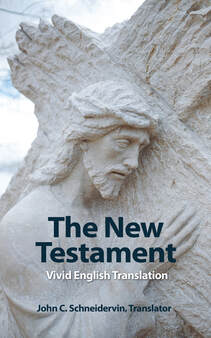|
Follow the sequence of what Jesus did, endured, and taught in those closing days of his Passion to redeem you. You will be able to walk with Jesus through what is now called Holy Week and observe on each successive day or evening where he went, what he did, what opposition he endured, what he taught, what he suffered, how he felt, and what exactly happened on Easter Sunday. So, follow Jesus now through his last earthly week and words for your eternal salvation.
|
The Years Of Christ's Three Year Ministry
The Four Gospels’ Record Of Christ’s Life And Work
The four gospels were each written with a somewhat different purpose and theme: Matthew-- Jesus Is the Messianic King; Mark-- Jesus Is the Christ, the Son of God; Luke-- Jesus Is Christ the Lord, the Savior of All; John-- Believe That Jesus is the Christ, the Son of God, So You May Have Eternal Life. The four gospels were not written as historical biographies of the life and work of Jesus Christ. They do not include every detail of Christ’s life and work either. As the apostle John stated in John 20:30 and 21:25, there were many miracles of Jesus that he did not record and many things that Jesus did that were not recorded. Had all the things that Jesus did been written in detail, John said, using hyperbole, the world itself would not have been able to contain them all.
What we have, then, are four historical sketches of the life and work of Christ. Each was written for a specific audience, purpose, and with its own theme. To arrive at a record of Christ’s life and work, one can only piece it together from the material in the four gospels. For example, except for the ministry of John the Baptist, the baptism of Jesus and his being tempted by the devil in the wilderness, the three synoptic gospels of Matthew, Mark, and Luke present nothing of the first year of Jesus’ public ministry. We know very little about that first year, and what we do know about it comes only from the Gospel of John. John’s gospel, on the other hand, presents nothing of the second year of Jesus’ public ministry. What we know of Jesus’ second year of ministry comes from the three synoptic gospels. More information is recorded about the second year of Jesus’ ministry than the first year, while the bulk of the material in the four gospels is about Jesus’ third year of ministry. Of that third year a substantial amount of the material is devoted to the last week of Jesus’ life and ministry--Holy Week. More than one-third of the gospels’ content is devoted to this last week.
A detailed outline of the three years of Jesus’ ministry can be, and has been, pieced together from the four gospels. To study such a detailed outline requires many hours of searching through the four gospels and comparing what is written in each. Such a study also requires some knowledge of the geography of Palestine at the time of Jesus’ ministry. For example, Jesus’ later Perean ministry in the third year of his public ministry is not necessarily introduced by a verse stating he went to Perea but that he traveled “beyond the Jordan,” which means he crossed to the east side of the Jordan River which brought him into the province of Perea. And, Jesus’ later Judean ministry in that same third year is not always indicated by the gospel verse stating Jesus entered Judea but that he went to Samaria or the village of Bethany which were both located in the province of Judea.
A detailed outline of where Jesus performed this or that miracle or taught this or that truth may be subject to debate. One biblical scholar may place one event of Jesus’ ministry in one place of his chronological sequence, while another biblical scholar may place that same event elsewhere in his chronological sequence. For example, one writer correctly placed Jesus’ preaching in Nazareth where he was rejected by his townspeople early in the second year of Jesus’ ministry. But that writer states that Jesus never returned to Nazareth. Another credible biblical scholar considers Mark 6:1-6a to be a second visit of Jesus to Nazareth near the end of Jesus’ second year of ministry. There is a good possibility that Jesus did visit Nazareth twice, first early in his second year of ministry, a second time near the end of that second year. Yet one cannot be dogmatic about this and insist that there was only one visit or that there must have been two visits.
A detailed outline of what occurred in each of the three years of Jesus’ ministry is pages long. Following it can be difficult and confusing as one looks up the respective verses, tries to discover why that incident is fitted into Jesus’ first, second, or third year of ministry, and compares one gospel account of that incident to the account of another of the gospels.
In spite of the difficulties researching the verses to piece together a detailed chronology of Jesus’ three-year ministry, a broad outline of those three years is clearly distinguishable. A very brief outline that gives a broad picture of the key events in the three years of Jesus’ ministry follows below.
The four gospels were each written with a somewhat different purpose and theme: Matthew-- Jesus Is the Messianic King; Mark-- Jesus Is the Christ, the Son of God; Luke-- Jesus Is Christ the Lord, the Savior of All; John-- Believe That Jesus is the Christ, the Son of God, So You May Have Eternal Life. The four gospels were not written as historical biographies of the life and work of Jesus Christ. They do not include every detail of Christ’s life and work either. As the apostle John stated in John 20:30 and 21:25, there were many miracles of Jesus that he did not record and many things that Jesus did that were not recorded. Had all the things that Jesus did been written in detail, John said, using hyperbole, the world itself would not have been able to contain them all.
What we have, then, are four historical sketches of the life and work of Christ. Each was written for a specific audience, purpose, and with its own theme. To arrive at a record of Christ’s life and work, one can only piece it together from the material in the four gospels. For example, except for the ministry of John the Baptist, the baptism of Jesus and his being tempted by the devil in the wilderness, the three synoptic gospels of Matthew, Mark, and Luke present nothing of the first year of Jesus’ public ministry. We know very little about that first year, and what we do know about it comes only from the Gospel of John. John’s gospel, on the other hand, presents nothing of the second year of Jesus’ public ministry. What we know of Jesus’ second year of ministry comes from the three synoptic gospels. More information is recorded about the second year of Jesus’ ministry than the first year, while the bulk of the material in the four gospels is about Jesus’ third year of ministry. Of that third year a substantial amount of the material is devoted to the last week of Jesus’ life and ministry--Holy Week. More than one-third of the gospels’ content is devoted to this last week.
A detailed outline of the three years of Jesus’ ministry can be, and has been, pieced together from the four gospels. To study such a detailed outline requires many hours of searching through the four gospels and comparing what is written in each. Such a study also requires some knowledge of the geography of Palestine at the time of Jesus’ ministry. For example, Jesus’ later Perean ministry in the third year of his public ministry is not necessarily introduced by a verse stating he went to Perea but that he traveled “beyond the Jordan,” which means he crossed to the east side of the Jordan River which brought him into the province of Perea. And, Jesus’ later Judean ministry in that same third year is not always indicated by the gospel verse stating Jesus entered Judea but that he went to Samaria or the village of Bethany which were both located in the province of Judea.
A detailed outline of where Jesus performed this or that miracle or taught this or that truth may be subject to debate. One biblical scholar may place one event of Jesus’ ministry in one place of his chronological sequence, while another biblical scholar may place that same event elsewhere in his chronological sequence. For example, one writer correctly placed Jesus’ preaching in Nazareth where he was rejected by his townspeople early in the second year of Jesus’ ministry. But that writer states that Jesus never returned to Nazareth. Another credible biblical scholar considers Mark 6:1-6a to be a second visit of Jesus to Nazareth near the end of Jesus’ second year of ministry. There is a good possibility that Jesus did visit Nazareth twice, first early in his second year of ministry, a second time near the end of that second year. Yet one cannot be dogmatic about this and insist that there was only one visit or that there must have been two visits.
A detailed outline of what occurred in each of the three years of Jesus’ ministry is pages long. Following it can be difficult and confusing as one looks up the respective verses, tries to discover why that incident is fitted into Jesus’ first, second, or third year of ministry, and compares one gospel account of that incident to the account of another of the gospels.
In spite of the difficulties researching the verses to piece together a detailed chronology of Jesus’ three-year ministry, a broad outline of those three years is clearly distinguishable. A very brief outline that gives a broad picture of the key events in the three years of Jesus’ ministry follows below.
The First Year Of Jesus' Ministry
|
The Event in Christ’s Life and Ministry:
Baptism of Jesus Jesus’ temptations in the wilderness Jesus begins gathering his first disciples. Jesus’ brief visit to Galilee where he performed his first miracle in Cana and stopped in Capernaum. Jesus’ early Judean ministry, which included his first cleansing of the temple and his talk with Nicodemus. Jesus’ return to Galilee. Enroute he speaks with the woman of Samaria at the well. He returns to Cana where he performed his second miracle. Jesus’ return to Judea to attend an unnamed feast in Jerusalem where he heals the man at the pool of Bethesda on the Sabbath that provokes the anger of the Jewish leaders. |
The Appropriate Gospel References:
Mt.3:13-17; Mk.1:9-11; Lk.3:21-22 Mt.4:1-11; Mk.1:12-13; Lk.4:1-13 Jn.1:29-51 Jn.2:1-12 Jn.2:13-4:3 Jn.4:3-54 Jn.5:1-47 |
The Second Year Of Jesus' Ministry
|
The Event in Christ’s Life and Ministry:
Jesus begins his great Galilean ministry of preaching repentance and that the kingdom of God is at hand. Jesus’ rejection in his hometown of Nazareth of Galilee and makes Capernaum in Galilee the headquarters for his great Galilean ministry. Jesus calls his disciples to begin following him full time. Jesus chooses but 12 of his disciples to be his apostles. Jesus’ Sermon on the Mount Jesus sends out his 12 apostles on their first ministry mission and instructs them. The story of John the Baptist’s murder by Herod, which occurred sometime earlier in Jesus’ 2nd year of ministry |
The Appropriate Gospel References:
Mt.4:17; Lk.4:14-15 Lk.4:16-31 Mt.4:17-22; Mk.1:16-20; Lk.5:1-11 Mt.10:2-4; Mk.3:13-19; Lk.12-16 Mt.5-7 Mt.10:5-11:1 Mt.14:1-12; Mk.6:14-29 |
The Third Year Of Jesus' Ministry
|
The Event in Christ’s Life and Ministry:
The four periods of Jesus’ retirements with his 12 disciples begins the third year of his ministry Jesus feeds the 5,000 Jesus refused to have the crowds make him their bread king and preaches he is the bread of life. Many disciples then turn away from him. Jesus’ transfiguration Jesus closes his Galilean ministry and conducts his later Judean and Perean ministry while enroute to Jerusalem to be crucified. Jesus raises Lazarus from the dead and the Jewish religious leaders plot Jesus’ murder to save their own positions. Jesus’ final journey to Jerusalem and his entrance into the city on Palm Sunday, which began Holy Week Holy Week of Jesus’ passion and resurrection Jesus’ last appearances to his disciples and his ascension into heaven |
The Appropriate Gospel References:
Mt.14:14-21; Mk.6:34-44; Lk.9:11-17; Jn.6:3-13 Jn.6:14-71 Mt.17:1-8; Mk.9:2-8; Lk.9:28-36a Lk.9:51-18:34; Jn.10:40-11:6 Jn.11:1-53 Mt.21:1-17; Mk.11:1-10; Lk.19:29-44; Jn.12:12-19 Mt.21:18-28:15; Mk.11:11-16:18; Lk.19:45-24:43; Jn.12:20-20:31 Mt.28:16-20; Mk.16:19-20; Lk.24:44-53; Jn.21:1-25 |
Return to New Testament History page





